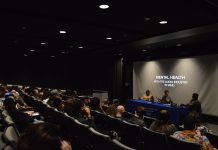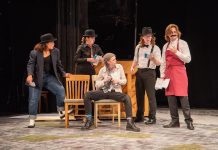
One musician played “Happy Birthday” on a xylophone. Another plucked a guitar. Someone else flung a trash can. All these sounds were performed in “Four6,” a piece that American musician John Cage composed in 1992 — the year he died.
“Four6” and other pieces of Cage’s work were brought back to life at a concert held at the Winifred-Moore Auditorium on Wednesday, Sept. 5, to celebrate his career. Webster faculty and students were the performers.
The approximately 90 minute concert was divided into three parts. The first was “In a Landscape,” which Cage composed in 1948. The second was “Indeterminacy,” which contained short stories a narrator read over instrumentals. The third part of the concert was called “Four6.” “Four” stands for the number of performers in the piece, while “6” represents the sixth piece Cage wrote.
Ty Schlabach, music composition major, said Cage’s music expands the idea of art. Schlabach said he thinks his music is designed to create controversy and push boundaries.
“When you poke around the boundaries, eventually I think things start to come out,” Schlabach said. “Sometimes they’re good, sometimes they’re bad, but it [Cage’s music] expands the repertoire of sounds and aesthetics you can work with.”
In “Four6,” the performers — who consisted of current students, faculty and an alumna of Webster — selected different instruments to play. The performers weren’t restricted to just instruments, though. They also used their voices, a record player, a whistle and a book, among other objects. The musicians had only rehearsed once the day before the concert.
Kate Peterson, an alumna who studied music composition while at Webster, was one of the performers who played in “Four6.” She said she is a fan of Cage, but that as a musician, she is more interested in Cage’s theories about listening than his music.
“There’s sound around you all the time,” Peterson said. “So the idea that you can find music wherever you go is fascinating to me.”
Cage is best known for his work “4’33,” which consists of four minutes and 33 seconds of silence. Cage invented the prepared piano. With a prepared piano, the sound is altered by placing objects between or on the strings. Cage has also been known for developing modern dance and has collaborated with Merce Cunningham, a dancer and choreographer, for most of his career.
“If they (the audience) sit through it and just kind of don’t make any prejudgments, I think the experience kind of washes on a person,” Schlabach said. “The next time they sit through a concert, they’ll be like, ‘Oh, OK.’”
Willem Von Hombracht, adjunct professor of the music department, said that a person’s work can not be summarized in one concert when they have written so much music. Von Hombracht said that one essential part of Cage’s life as a musician was his love for listening.
“He was trying to get everybody else to enjoy listening as much as he did,” Von Hombracht said. “He was trying to get people to open their ears and listen without preconceptions.”



